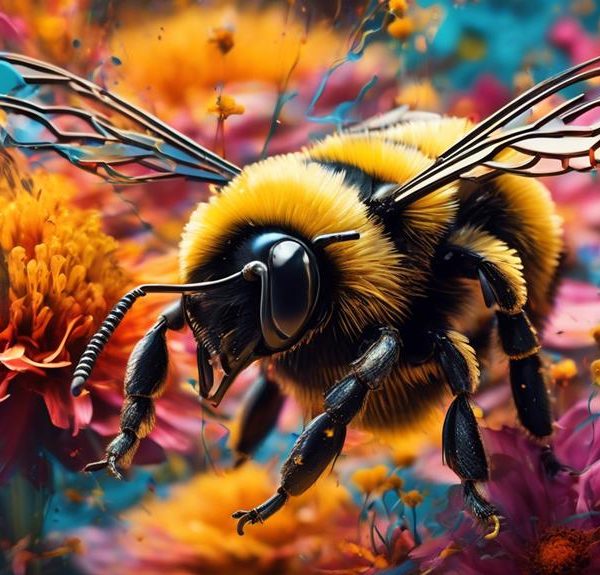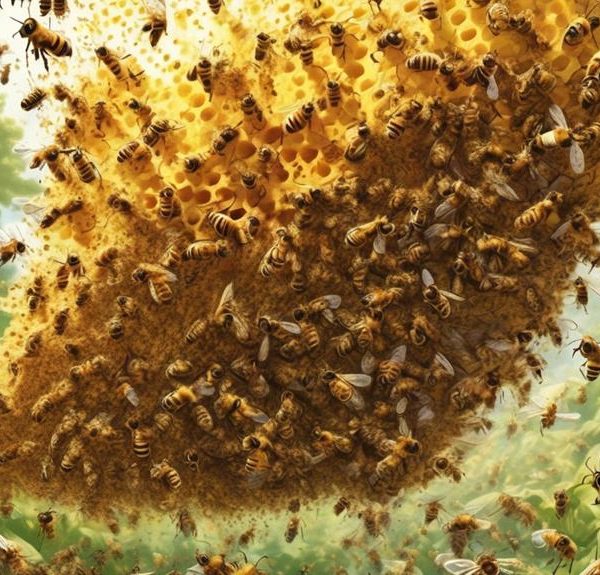Marvel at the curious reasons why your dog might be tempted to snack on bees and learn how to protect your furry friend.

Why Does My Dog Eat Bees?
You might think your furry friend's foray into the world of bees is a sign of a strange, unexplainable canine quirk, but it's actually a more common phenomenon than you'd expect.
Dogs, particularly young ones, are creatures of curiosity and their exploratory nature can often lead them into potentially dangerous situations, like eating bees.
Now, you're probably wondering, 'Why on earth would my dog want to eat bees?' and 'Isn't this harmful?' Let's unfold this intriguing behavior and its potential implications for your pet's health, while also considering effective preventive measures you can take.
By the end of this discussion, you'll be well equipped to handle the buzzing situation.
Key Takeaways
- Dogs have a natural curiosity driven by their genetic makeup, which leads them to explore their surroundings with their noses and mouths, including bees.
- Eating bees can pose risks to dogs, including bee stings that can cause pain, swelling, and irritation, as well as potential allergic reactions that can be severe and life-threatening.
- Bee stings inject venom into dogs, causing immediate pain and swelling, and the severity of the reaction depends on the dog's immune response and the number of stings.
- Dog owners can take preventive measures to minimize the risk of their dogs eating bees, such as being aware of when bees are most active, removing potential bee nests from the yard, and training their dogs to come to them on command.
Understanding Canine Curiosity
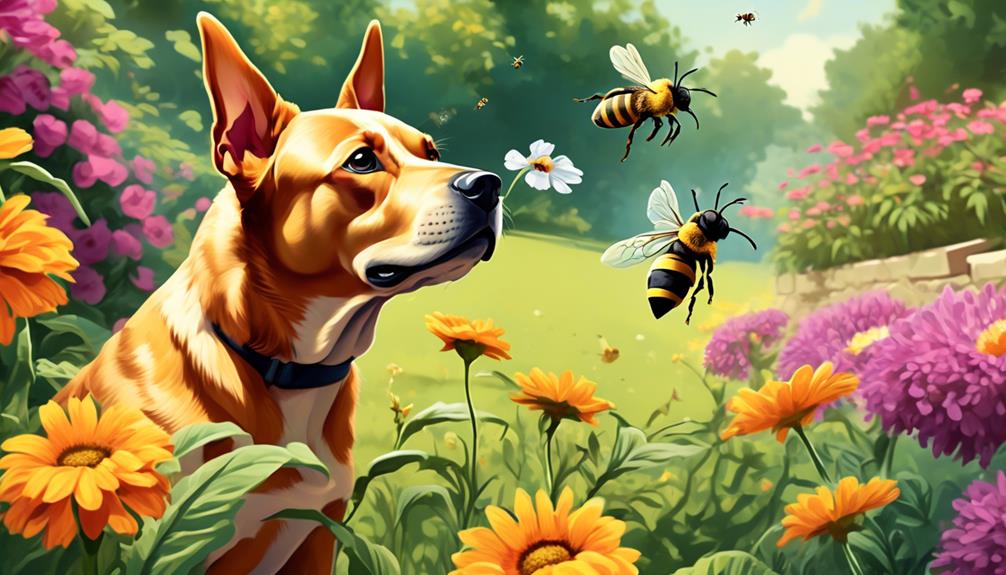
To grasp why dogs often go after bees, it's crucial to delve into the inherent curiosity that dogs possess, which frequently drives them to explore their surroundings with their noses and mouths. This behavioral trait is deeply rooted in a dog's genetic makeup, dating back to their ancestors' need to hunt and scavenge for survival.
You might've noticed your dog sniffing around the yard, poking at peculiar objects, or even chasing after moving things. This is their innate curiosity at play. It's this curiosity, however, that sometimes leads them straight to a buzzing bee. The movement and sound of a bee serve as intriguing stimuli, capturing your dog's attention immediately. They're simply following their natural instincts, unaware of the potential danger that comes with a bee sting.
However, it's important to note that not all dogs will chase after bees. Factors such as breed, age, and individual temperament play a significant role in how curious a dog might be. Regardless, understanding this aspect of your dog's behavior can help you anticipate potential dangers and keep your furry friend safe.
The Risk Factors for Dogs

While your dog's curiosity can sometimes lead to harmless fun, it's crucial to understand the potential risks they might face when interacting with bees. The most immediate risk is a bee sting, which can cause localized pain, swelling, or irritation on your dog's skin. Dogs often get stung in the mouth or throat because they try to catch the bees, which can lead to more severe reactions.
Moreover, some dogs may develop an allergic reaction to bee stings. This could lead to anaphylaxis, a severe and life-threatening allergic reaction. Symptoms include sudden vomiting, diarrhea, swelling of the face or paws, difficulty breathing, and collapse.
Additionally, repeated exposure to bee stings might lead to a greater risk of developing an allergy. Therefore, it's vital to discourage this behavior as much as possible. If your dog is stung, it's advisable to seek immediate veterinary attention. Remember, prevention is always better than cure. Ensuring your dog avoids bees and other stinging insects is the best way to minimize these potential risks.
Bee Stings and Dog Health
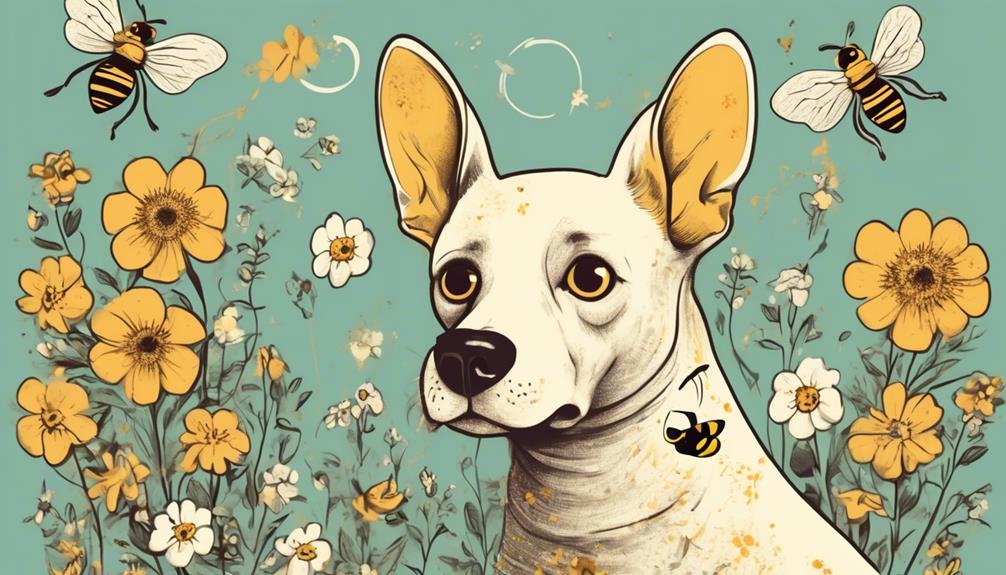
Navigating the world of bee stings and their impact on your dog's health can be a daunting task. It's essential to understand that when your pup decides to snack on a buzzing bee, they're risking a painful sting.
When a bee stings your dog, it injects venom that can cause immediate pain and swelling. You'll often notice your dog pawing at their face or shaking their head. Some dogs may even yelp or start drooling. The severity of the reaction depends on your dog's immune response and the number of stings.
Severe reactions may include difficulty breathing, weakness, vomiting, diarrhea, and even anaphylaxis, a life-threatening allergic reaction. If you observe any of these symptoms, it's crucial to get your pet to a vet as soon as possible.
Bee stings can't always be avoided, but you can minimize the risk. If you notice your dog showing interest in bees, redirect their attention. Keep them on a leash during walks to avoid encounters and always monitor them while they're outside.
Preventive Measures for Pet Owners
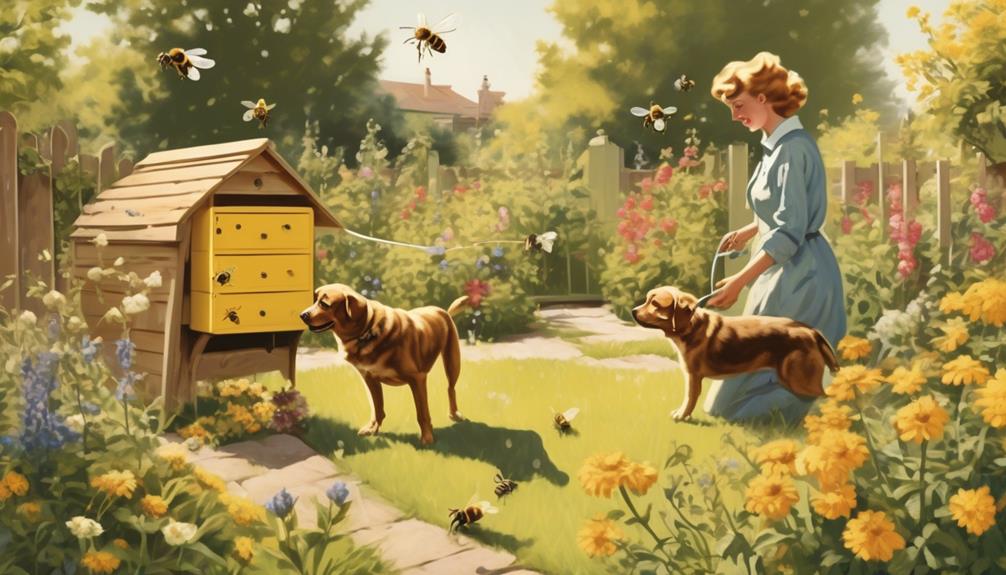
So, how can you protect your furry friend from these potentially harmful encounters with bees? The first step towards prevention is awareness. Understand the times when bees are most active – typically during spring and summer days. If you're out with your pet during these periods, be extra vigilant.
Next, ensure your yard isn't attracting bees. Regularly inspect it and remove any potential bee nests. Bees are also attracted to certain flowers and plants, so consider this when landscaping. Furthermore, providing a different water source for bees can help keep them away from your dog's play area.
But what if a bee does approach your pet? Train your dog to come to you on command. This can help you distract your dog and prevent an encounter. If your dog gets stung, don't panic. Quickly remove the stinger without squeezing it, and apply a cold pack to reduce swelling. If your dog shows any signs of an allergic reaction, such as difficulty breathing or excessive swelling, immediately contact your vet.
Your proactive approach can ensure that your pet's curiosity doesn't lead to a painful, dangerous encounter.
Dealing With a Bee-Sting Incident
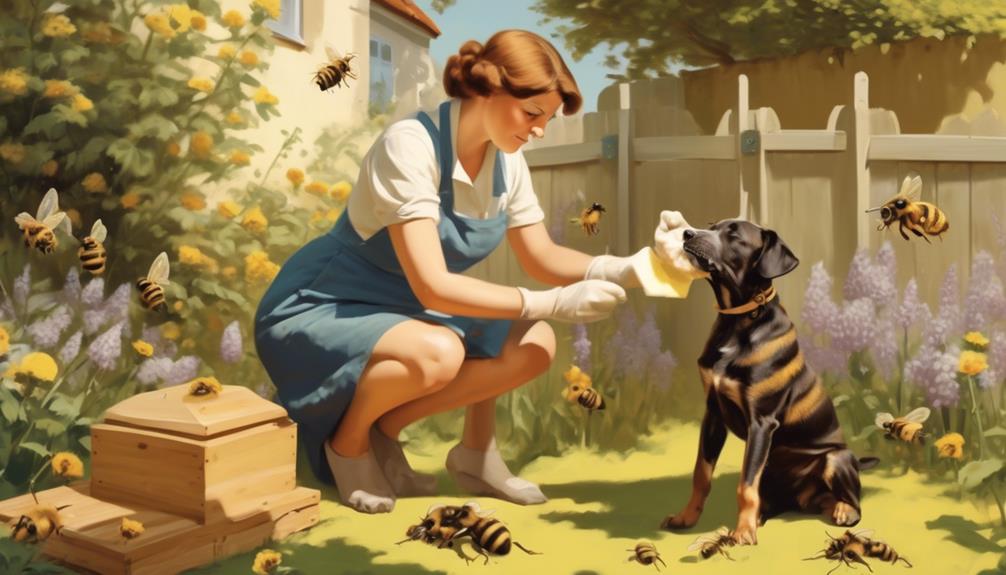
When your dog does get stung by a bee, it's crucial to know exactly how to handle the situation swiftly and effectively. First, try to remove the stinger if it's visible, but be careful not to squeeze it, as this can release more venom. You can use a credit card or similar object to scrape it off gently.
Next, you'll need to monitor your dog for any signs of an allergic reaction. This could include difficulties in breathing, excessive drooling, vomiting, or diarrhea. If any of these symptoms occur, contact your vet immediately.
Meanwhile, to alleviate pain and reduce swelling, apply a cold compress to the affected area. You can make a simple compress by wrapping ice in a cloth and holding it against the sting for about 10 minutes.
Lastly, keep a close eye on your dog for the next 24 hours. If your dog's condition worsens or doesn't improve, it's time to seek professional help. Remember, prompt and appropriate action can make all the difference when dealing with a bee sting.
Don't hesitate to contact your vet if you're unsure about any aspect of your dog's health. Your furry friend's well-being is always worth the call!
Frequently Asked Questions
What Other Animals or Insects Are Commonly Eaten by Dogs Out of Curiosity?
Dogs, being naturally curious creatures, often explore their surroundings with their mouths. This includes eating various animals and insects. They're known to consume rodents like squirrels and mice, birds, and even other insects like spiders and flies.
Are There Specific Breeds of Dogs More Likely to Eat Bees?
Certain dog breeds aren't more inclined to eat bees. It's more about a dog's individual personality and curiosity. If your pup's adventurous and tends to explore with its mouth, it might end up eating a bee. Remember, though, it's dangerous as bees can sting inside their mouth or throat.
Always keep an eye on your dog when they're outside, especially in areas where bees are present.
How Can I Train My Dog to Avoid Bees and Other Dangerous Insects?
Training your dog to avoid bees and other dangerous insects is crucial for their safety. Start with basic commands like 'leave it' or 'no'. Reinforce these commands with rewards.
Use a toy or a picture of a bee to simulate scenarios. Ensure to supervise your dog during outdoor activities. If they start showing interest in insects, distract them and redirect their attention.
What Kind of Behavior Should I Expect From My Dog After It Has Eaten a Bee?
After your dog has eaten a bee, you might notice some immediate changes in their behavior. They'll likely be in discomfort, pawing at their mouth or face. If stung, they may display signs of allergic reactions like swelling, excessive drooling, difficulty breathing, or collapse. In severe cases, they could go into anaphylactic shock.
It's crucial to monitor them closely and seek immediate veterinary care if any concerning symptoms arise.
Are There Any Home Remedies I Can Use if My Dog Gets Stung by a Bee?
Sure, there are a few home remedies you can try.
First, remove the stinger if it's visible, using a credit card to scrape it out. Don't use tweezers as you might squeeze more venom out.
Then, make a paste of baking soda and water, and apply it to the sting area. This can help reduce the pain and swelling.
However, if your dog shows severe symptoms like difficulty breathing, it's best to seek immediate veterinary care.
Conclusion
In conclusion, your dog's bee-eating habit stems from its natural curiosity and playfulness. But remember, this poses serious health risks, including painful stings and potential allergies.
It's crucial to take preventive measures, like monitoring outdoor play and keeping your yard bee-free. If a bee-sting incident does occur, swift, proper care is essential.
As a responsible pet owner, understanding and managing these risks is key to ensuring your dog's well-being.

